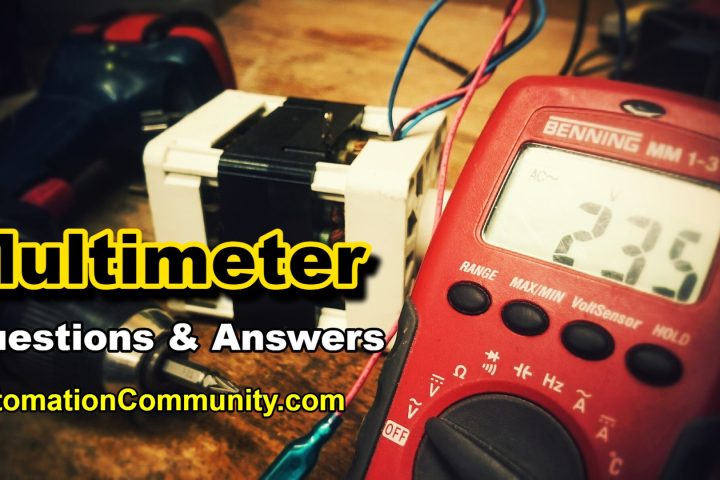Instrumentation Engineering Formulas Questions in Industry
Instrumentation engineering plays a vital role in the smooth functioning of various industrial processes for monitoring and controlling applications. Instrumentation engineers use various formulas and equations for troubleshooting and maintenance of industrial instruments and control systems.
Instrumentation Engineering Formulas

In this set of questions and answers, we will cover some of the most important formulas and equations used in instrumentation engineering, including those related to control systems, process variables, 4-20 mA, and signal analysis.
What is the formula for calculating the process variable (PV) of a system with a 4-20 mA current loop?
A. PV = (I/Ispan)(PVmax – PVmin) + PVmin
B. PV = (I/Ispan)(PVmin – PVmax) + PVmin
C. PV = (I/Ispan)(PVmax – PVmin) – PVmin
D. PV = (I/Ispan)(PVmin – PVmax) – PVmin
Answer: A
Explanation: The process variable (PV) of a system with a 4-20 mA current loop can be calculated using the formula PV = (I/Ispan)*(PVmax – PVmin) + PVmin
Where I is the current in mA, Ispan is the span of the current loop in mA, PVmax is the maximum value of the process variable, and PVmin is the minimum value of the process variable.
What is the formula for calculating the percentage of a process variable (%PV) in a system with a 4-20 mA current loop?
A. %PV = (I/Ispan)4%
B. %PV = (I/Ispan)20%
C. %PV = (I/Ispan)5%
D. %PV = (I/Ispan)100%
Answer: D
Explanation: The percentage of a process variable (%PV) in a system with a 4-20 mA current loop can be calculated using the formula %PV = (I/Ispan)*100%
Where I is the current in mA and Ispan is the span of the current loop in mA.
What is the formula for converting a percentage of a process variable (%PV) to a process variable (PV) in a system with a 4-20 mA current loop?
A. PV = (%PV/100)(PVmax – PVmin) * PVmin
B. PV = (%PV/100)(PVmax – PVmin) + PVmin
C. PV = (%PV/100)(PVmax – PVmin) – PVmin
D. PV = (%PV/100)(PVmin – PVmax) – PVmin
Answer: B
Explanation: To convert a percentage of a process variable (%PV) to a process variable (PV) in a system with a 4-20 mA current loop, use the formula PV = (%PV/100)*(PVmax – PVmin) + PVmin
Where %PV is the percentage of the process variable, PVmax is the maximum value of the process variable, and PVmin is the minimum value of the process variable.
What is the formula for converting a process variable (PV) to a 4-20 mA signal in a system with a 4-20 mA current loop?
A. I = (PV – PVmin)(Ispan/(PVmax – PVmin)) + 4 mA
B. I = (PVmax – PV)(Ispan/(PVmax – PVmin)) + 4 mA
C. I = (PV – PVmin)(Ispan/(PVmax – PVmin)) – 4 mA
D. I = (PVmax – PV)(Ispan/(PVmax – PVmin)) – 4 mA
Answer: B
Explanation:
The correct formula for converting a process variable (PV) to a 4-20 mA signal in a system with a 4-20 mA current loop is:
I = (PVmax – PV)(Ispan/(PVmax – PVmin)) + 4 mA
In this formula:
I represent the current value in mA
PV is the process variable value
PVmax and PVmin are the maximum and minimum values of the process variable, respectively
Ispan is the span of the current loop, which is the difference between the maximum and minimum current values (20 mA – 4 mA = 16 mA)
By subtracting the process variable (PV) from the maximum value (PVmax), dividing it by the range of the process variable (PVmax – PVmin), multiplying it by the span of the current loop (Ispan), and adding the minimum current value (4 mA), we obtain the current signal (I) corresponding to the given process variable.
What is the formula for calculating the current (I) in a system with a 4-20 mA current loop and a resistance (R) of 250 ohms?
A. I = (V – 4)/16
B. I = (V – 20)/(-16)
C. I = V/250
D. I = (V – 250)/(-16)
Answer: A
Explanation: In a system with a 4-20 mA current loop and a resistance (R) of 250 ohms, the current (I) can be calculated using the formula I = (V – 4)/16, where V is the voltage across the loop.
What is the formula for calculating the voltage (V) in a system with a 4-20 mA current loop and a resistance (R) of 250 ohms?
A. V = I250
B. V = I4 + 250
C. V = I16
D. V = I20 – 4
Answer: C
Explanation: In a system with a 4-20 mA current loop and a resistance (R) of 250 ohms, the voltage (V) can be calculated using the formula V = I*16, where I is current in mA.
What is the formula for calculating the resistance (R) in a system with a 4-20 mA current loop and a voltage (V) of 24 V?
A. R = (V – 4)/0.02
B. R = (V – 20)/0.02
C. R = V/0.02
D. R = (V – 24)/0.02
Answer: C
Explanation: In a system with a 4-20 mA current loop and a voltage (V) of 24 V, the resistance (R) can be calculated using the formula R = V/0.02, where 0.02 is current in A (20 mA).
What is the formula for calculating the percentage of a process variable (%PV) in a system with a 0-10 V voltage loop?
A. %PV = (V/Vspan)100%
B. %PV = (V/Vspan)10%
C. %PV = (V/Vspan)5%
D. %PV = (V/Vspan)1%
Answer: A
Explanation: The percentage of a process variable (%PV) in a system with a 0-10 V voltage loop can be calculated using the formula %PV = (V/Vspan)*100%, where V is the voltage, and Vspan is the span of the voltage loop in volts.
What is the formula for converting a percentage of a process variable (%PV) to a process variable (PV) in a system with a 0-10 V voltage loop?
A. PV = (%PV/100)(PVmax – PVmin) + PVmin
B. PV = (%PV/10)(PVmin – PVmax) + PVmin
C. PV = (%PV/5)(PVmax – PVmin) – PVmin
D. PV = (%PV/1)(PVmin – PVmax) – PVmin
Answer: A
Explanation: To convert a percentage of a process variable (%PV) to a process variable (PV) in a system with a 0-10 V voltage loop, use the formula PV = (%PV/100)*(PVmax – PVmin) + PVmin
Where %PV is the percentage of the process variable, PVmax is the maximum value of the process variable, and PVmin is the minimum value
What is the formula for converting a process variable (PV) to a percentage of a process variable (%PV) in a system with a 0-10 V voltage loop?
A. %PV = ((PV – PVmin)/(PVmax – PVmin))4%
B. %PV = ((PV – PVmax)/(PVmin – PVmax))20%
C. %PV = ((PV – PVmin)/(PVmax – PVmin))100%
D. %PV = ((PV – PVmax)/(PVmin – PVmax))16%
Answer: C
Explanation: To convert a process variable (PV) to a percentage of a process variable (%PV) in a system with a 0-10 V voltage loop, use the formula %PV = ((PV – PVmin)/(PVmax – PVmin))*100%
Where PVmin is the minimum value of the process variable, PVmax is the maximum value of the process variable, and PV is the current value of the process variable.
What is the formula for calculating the current (I) in a system with a 0-10 V voltage loop and a resistance (R) of 500 ohms?
A. I = V/R
B. I = (10 – V)/500
C. I = V/500
D. I = (V – 10)/(-500)
Answer: C
Explanation: In a system with a 0-10 V voltage loop and a resistance (R) of 500 ohms, the current (I) can be calculated using the formula I = V/R, where V is the voltage across the loop.
What is the formula for calculating the voltage (V) in a system with a 0-10 V voltage loop and a current (I) of 20 mA?
A. V = IR
B. V = 10 – I500
C. V = I500
D. V = I(-10)
Answer: C
Explanation: In a system with a 0-10 V voltage loop and a current (I) of 20 mA, the voltage (V) can be calculated using the formula V = I*500, where 500 is the resistance in ohms.
What is the formula for calculating the process variable (PV) in a system with a 4-20 mA current loop and a range of 0-100 psi?
A. PV = (I + 4)(100/16)
B. PV = (I – 20)(100/(-16))
C. PV = I*(100/16)
D. PV = (I – 4)(100/16)
Answer: D
Explanation: In a system with a 4-20 mA current loop and a range of 0-100 psi, the process variable (PV) can be calculated using the formula PV = (I – 4)(100/16), where I is the current in mA.
What is the formula for converting a process variable (PV) in psi to a process variable (PV) in kPa?
A. PV(kPa) = PV(psi)+6.895
B. PV(kPa) = PV(psi)/6.895
C. PV(kPa) = PV(psi)0.145
D. PV(kPa) = PV(psi)6.895
Answer: D
Explanation: To convert a process variable (PV) in psi to a process variable (PV) in kPa, use the formula PV(kPa) = PV(psi)*6.895, where 6.895 is the conversion factor from psi to kPa.
What is the formula for calculating the resistance of a 100-ohm platinum RTD at a temperature of 0°C (32°F)?
A. R0 = 100Ω (1 + 0.00385 * 0)
B. R0 = 100Ω (1 + 0.00385 * (0 – 32))
C. R0 = 100Ω / (1 + 0.00385 * 0)
D. R0 = 100Ω / (1 + 0.00385 * (0 – 32))
Answer: A
Explanation: The formula for calculating the resistance of a 100-ohm platinum RTD at a temperature of 0°C (32°F) is R0 = 100Ω (1 + 0.00385 * 0)
Where R0 is the resistance at 0°C and 0.00385 is the temperature coefficient of resistance for platinum.
What is the formula for converting the resistance of a 100-ohm platinum RTD to a temperature reading in Celsius (°C)?
A. T = (Rt – R0) / (0.00385 * Rt)
B. T = (Rt / R0 – 1) / 0.00385
C. T = (Rt – R0) / (0.00385 * R0)
D. T = (Rt / R0 – 1) / (0.00385 * R0)
Answer: C
Explanation: To convert the resistance of a 100-ohm platinum RTD to a temperature reading in Celsius (°C), use the formula T = (Rt – R0) / (0.00385 * R0)
Where Rt is the measured resistance and R0 is the resistance at 0°C.
What is the formula for calculating the temperature coefficient of resistance (TCR) for a 100-ohm platinum RTD?
A. TCR = (R100 – R0) / (100 * R0 * T)
B. TCR = (R100 – R0) / (100 * R0 * (T – 273))
C. TCR = (R100 / R0 – 1) / (100 * T)
D. TCR = (R100 / R0 – 1) / (100 * (T – 273))
Answer: B
Explanation: The formula for calculating the temperature coefficient of resistance (TCR) for a 100-ohm platinum RTD is TCR = (R100 – R0) / (100 * R0 * (T – 273))
Where R100 is the resistance at 100°C, R0 is the resistance at 0°C, and T is the temperature in Kelvin.
What is the formula for calculating the resistance of a 100-ohm copper RTD at a temperature of 100°C?
A. R100 = 100Ω (1 + 0.00428 + 100)
B. R100 = 100Ω (1 + 0.00428 * (100 – 32))
C. R100 = 100Ω (1 + 0.00428 * 100)
D. R100 = 100Ω / (1 + 0.00428 * (100 – 32))
Answer: A
Explanation: The formula for calculating the resistance of a 100-ohm copper RTD at a temperature of 100°C is R100 = 100Ω (1 + 0.00428 * 100), where R100 is the resistance at 100°C.
A pressure transmitter has a range of 0-3000 psi and a 4-20 mA output signal. If the transmitter is currently measuring a pressure of 1500 psi, what is the output signal in percent (%FS)?
A. 25%
B. 50%
C. 75%
D. 100%
Answer: B
Explanation: To calculate the output signal in percent of full scale (%FS), we can use the formula:
%FS = (measurement – minimum range) / (maximum range – minimum range) x 100
%FS = (1500 – 0) / (3000 – 0) x 100
%FS = 50%
A temperature transmitter using a thermocouple has an output voltage of 5 mV. If the reference junction is at 20°C and the hot junction is at an unknown temperature, what is the temperature of the hot junction if the type of thermocouple being used is a J-type?
A. 147°C
B. 210°C
C. 240°C
D. 310°C
Answer: B
Explanation: Using the standard thermocouple reference tables for a J-type thermocouple, we can determine the temperature of the hot junction based on the output voltage and the temperature difference between the hot and reference junctions.
For an output voltage of 5 mV, we can see that this corresponds to a temperature difference of approximately 190°C. Adding this to the reference junction temperature of 20°C gives a hot junction temperature of 210°C.
A level transmitter using a capacitance sensor has a range of 0-20 feet and a 4-20 mA output signal. If the transmitter is currently measuring a level of 15 feet, what is the output signal in milliamps (mA)?
A. 12.8 mA
B. 18.0 mA
C. 16 mA
D. 20.0 mA
Answer: C
Explanation:
To determine the output signal in milliamps (mA) for a level transmitter using a capacitance sensor, given a range of 0-20 feet and a current range of 4-20 mA, we can use the following linear relationship:
Output signal = (Level – Lower Range) * (Output Range / Range) + Lower Output
In this equation:
Level is the measured level in feet
Lower Range is the lower end of the range (0 feet)
Output Range is the range of the output signal (20 mA – 4 mA = 16 mA)
Range is the range of the level measurement (20 feet – 0 feet = 20 feet)
Lower Output is the lower end of the output signal (4 mA)
Substituting the given values, we have:
Output signal = (15 – 0) * (16 mA / 20 feet) + 4 mA
Output signal = 15 * (16 mA / 20 feet) + 4 mA
Output signal = 12 mA + 4 mA
Output signal = 16 mA
Therefore, the output signal in milliamps (mA) for a level measurement of 15 feet in a range of 0-20 feet with a 4-20 mA current signal is 16 mA.
What is the formula for converting a flow rate in liters per minute (LPM) to gallons per hour (GPH)?
A. GPH = LPM * 15.85
B. GPH = LPM * 3.785
C. GPH = LPM / 0.063
D. GPH = LPM * 0.063
Answer: A
Explanation: To convert a flow rate in liters per minute (LPM) to gallons per hour (GPH), use the formula GPH = LPM * 15.85, where LPM is the flow rate in liters per minute.
What is the formula for calculating the volume (V) of a cylindrical tank with a diameter (D) of 2 meters and a height (H) of 4 meters?
A. V = π * (D/2)^2 + H
B. V = π * (D/2)^2 / H
C. V = π * D^2 * H / 4
D. V = π * (D/2)^2 * H
Answer: D
Explanation: The volume (V) of a cylindrical tank with a diameter (D) of 2 meters and a height (H) of 4 meters can be calculated using the formula V = π * (D/2)^2 * H, where D is the diameter in meters and H is the height in meters.
What is the formula for calculating the flow rate (Q) of a liquid with a density (ρ) of 1000 kg/m3, a pipe diameter (D) of 0.3 meters, and a velocity (v) of 2 m/s?
A. Q = π * (D/2)^2 * v
B. Q = ρ * π * (D/2)^2 * v
C. Q = ρ * π * D^2 * v / 4
D. Q = π * D^2 * v / 4
Answer: C
Explanation: The flow rate (Q) of a liquid with a density (ρ) of 1000 kg/m3, a pipe diameter (D) of 0.3 meters, and a velocity (v) of 2 m/s can be calculated using the formula Q = ρ * π * D^2 * v / 4, where D is the pipe diameter in meters, v is the fluid velocity in m/s, and ρ is the fluid density in kg/m3.
Read Next:














